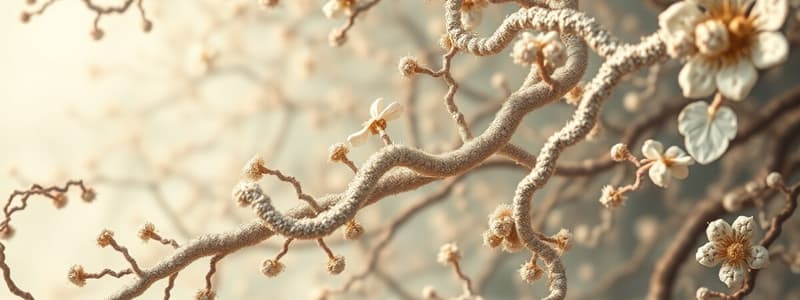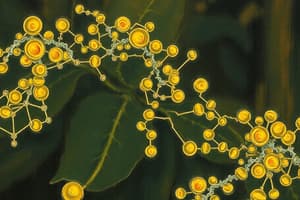Podcast
Questions and Answers
Which of the following is a state of matter?
Which of the following is a state of matter?
- Solid
- Liquid
- Gas
- All of the above (correct)
What is the unique substance that cannot be broken down by ordinary chemical means?
What is the unique substance that cannot be broken down by ordinary chemical means?
Element
What are the building blocks for each element?
What are the building blocks for each element?
Atoms
What percentage of body weight is attributed to Oxygen, Hydrogen, Carbon, and Nitrogen?
What percentage of body weight is attributed to Oxygen, Hydrogen, Carbon, and Nitrogen?
Which of the following is a major element of the human body?
Which of the following is a major element of the human body?
What is the mass of a proton?
What is the mass of a proton?
Electrons have a mass of 1 amu.
Electrons have a mass of 1 amu.
An isotope is defined by having the same number of protons but a different number of ________.
An isotope is defined by having the same number of protons but a different number of ________.
What type of bond is formed when one atom loses an electron and another accepts that electron?
What type of bond is formed when one atom loses an electron and another accepts that electron?
What rule suggests that atoms interact to have eight electrons in their valence shell?
What rule suggests that atoms interact to have eight electrons in their valence shell?
Which of the following describes a covalent bond?
Which of the following describes a covalent bond?
What type of molecules result from unequal sharing of electrons?
What type of molecules result from unequal sharing of electrons?
Molecules and compounds are the same thing.
Molecules and compounds are the same thing.
Dissociated ions that can conduct electricity are known as ________.
Dissociated ions that can conduct electricity are known as ________.
Flashcards are hidden until you start studying
Study Notes
The Chemical Basis of Life
- Matter is defined as anything that has mass and occupies space.
- States of matter include:
- Solid: definite shape and volume
- Liquid: definite volume, changeable shape
- Gas: changeable shape and volume
Composition of Matter
- Elements are unique substances that cannot be broken down chemically.
- Atoms serve as the basic building blocks for each element.
- Each element has a corresponding atomic symbol, which consists of one or two letters.
Properties of Elements
- Each element has distinct physical properties (detectable by senses) and chemical properties (related to atomic interactions).
Major Elements of the Human Body
- Approximately 96% of body weight consists of:
- Oxygen (O)
- Hydrogen (H)
- Carbon (C)
- Nitrogen (N)
- Lesser elements account for 3.9%:
- Phosphorus (P), Potassium (K), Calcium (Ca), Sulfur (S), Sodium (Na), Chlorine (Cl), Magnesium (Mg), Iodine (I), Iron (Fe)
- Trace elements make up less than 0.01% and are essential in minimal quantities, often as parts of enzymes.
Atomic Structure
- The nucleus of an atom comprises neutrons (no charge, 1 amu) and protons (positive charge, 1 amu).
- Electrons (negative charge, 1/2000 amu) orbit the nucleus, maintaining electrical neutrality because the number of protons and electrons is equal.
Identification of Elements
- Atomic number: equals the number of protons in an atom.
- Mass number: the sum of protons and neutrons.
- Atomic weight: the average mass of an element's isotopes.
- Isotopes are atoms with the same number of protons but varying neutrons.
Chemical Bonds
- Electron shells around the nucleus participate in bond formation through valence electrons.
- The valence shell is the outermost energy level with active electrons.
- The octet rule describes atoms' tendency to have eight electrons in their valence shell, aside from the first shell, which holds two.
Types of Chemical Bonds
- Ionic bonds: occur when one atom transfers an electron to another.
- Covalent bonds: formed by sharing electrons between atoms.
- Hydrogen bonds: occur between hydrogen atoms covalently bound to nitrogen or oxygen, creating weak attractions with other atoms.
Ionic Bonds
- Ionic bonds result from electron transfer between atoms.
- Ions are charged atoms due to electron gain (anions) or loss (cations).
- Ionic compounds like NaCl form crystalline structures instead of distinct molecules.
Covalent Bonds
- Covalent bonds arise from the sharing of two or more electrons, forming molecules.
- A single covalent bond involves a pair of shared electrons.
- A double covalent bond consists of two pairs of shared electrons.
Polar and Nonpolar Molecules
- Nonpolar molecules feature equally shared electrons.
- Polar molecules result from unequal sharing of electrons.
Hydrogen Bonds
- Hydrogen bonds are weak, cannot bind atoms but are prevalent in molecules like water, contributing to properties like surface tension.
- Important for maintaining the 3D shapes of molecules.
Molecules and Compounds
- A molecule consists of two or more atoms bonded together, functioning as a unit.
- A compound contains two or more different types of atoms chemically combined, either as covalent (molecule) or ionic (array of ions) compounds.
Dissociation
- Dissociation refers to the separation of ions in an ionic compound by polar water molecules.
- Dissociated ions, known as electrolytes, can conduct electricity.
- Molecules that don't dissociate in water do not form electrolytes.
Studying That Suits You
Use AI to generate personalized quizzes and flashcards to suit your learning preferences.




